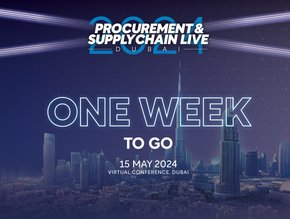Procurement and best practice for Scope 3 reporting

With Scope 3 emissions coming in to play, it is vital that procurement operations know the impact their supply chain has on the business and their emissions reporting.
How can procurement professionals adopt best practice in making sure they are prepared to play their role in sustainable practice.
John Marchisin is a managing director at global management and technology consulting firm AArete, and explains to Procurement Magazine best practice in Scope 3 Emissions reporting.

Why are businesses needing to be ready to report their Scope 3 emissions?
Scope 3 emissions – the next step in environmental reporting – is here, meaning leaders must begin implementing repeatable, scalable processes to accurately collect and calculate greenhouse gases (GHG) emitted by their supply chain partners.
Companies across all industries face significant challenges measuring sustainability efforts and their progress toward a goal of net zero emissions. First, there was reporting for Scope 1 emissions (from sources that an organisation owns or controls). Next, came Scope 2 emission reports (GHG releases associated with the purchase of electricity for cooling or heating, or use of steam power).
The newest, Scope 3 emissions, measures the amount of GHG being released by companies in an organisation’s supply chain. It adds a new level of complexity and timeliness, especially since U.S. regulators, for example, have provided guidance for publicly traded companies on reporting Scope 3 emissions.
Amazon added to the urgency when it disclosed in its annual Sustainability Report that beginning in 2024 it will “require suppliers to share their carbon emissions data with us and set carbon goals.” Businesses that now work with Amazon will have to comply with emissions reporting standards – or lose out on working with one of the world’s largest global retailers. It also reinforces the strategy to act now when it comes to reporting Scope 3 emissions and not wait until federal regulations are finalised.
Most organisations are not prepared for Scope 3 emissions reporting, and for valid reasons. Without a best-practices framework, the emissions data is generally gathered through inefficient manual processes. The lack of a roadmap, and staffing strain, make it increasingly difficult for companies to repeat the process.
What are the different approaches to calculating Scope 3 emissions?
Companies can use a few approaches to collect and calculate Scope 3 emissions, but most rely on one of two methodologies: spend-based or primary data capture.
The spend-based method of carbon accounting is calculated by multiplying the cost of a purchased good or service by a corresponding emission factor. Companies base their calculations on the U.S. Environmental Protection Agency’s Environmentally Extended Input-Output Dataset (EEIO), a widely accepted benchmark for measuring emissions across 410 different categories.
Pros: Spend-based analysis is the quickest way to know which goods and services and which partners in your supply chain contribute the most emissions. The initial analysis can be completed quickly, and the process can be repeated and modified as standards change.
Cons: The spend-based method can be a time-consuming, manual process if companies do not have a robust technology that collects, analyses and reports sustainability data. Additionally, companies must make any necessary modifications to their calculations when the EPA updates the EEIO dataset. The spend-based approach also does not work for select expense categories, such as health insurance or payroll processing, for example, which could result in over-estimating emissions without adjustments.
What is the primary data capture method?
The primary data capture method calculates emissions by collecting data that is provided by each company in an organisation’s supply chain.
Pros: This can be the most precise method for gathering supplier emissions. The approach also opens the door to collaboration with suppliers to reduce emissions.
Cons: Most companies do not have an accurate baseline of their emissions or the granularity to calculate the emissions generated by a specific product or service purchase. For most organisations, reaching out and gathering feedback from hundreds or thousands of suppliers is simply too time consuming and resource intensive. There are low response rates from suppliers, and most suppliers do not have the information or the ability to provide it in a timely manner. Another big hurdle is that the outreach and data collection would have to be repeated each year.
How can you build a plan for successful reporting?
Regardless of the method used to measure Scope 3 emissions, the best practices remain the same, and will help leaders implement a roadmap to success. I believe there are three main areas to focus on.
- Automate the process: Whether it is using your organisation’s business intelligence tools or using an outside vendor’s technology, automating the process of data gathering, consolidation and reporting will alleviate one of the most significant pain points with Scope 3 emissions management: staffing strain. When automating the process, remember that the methodology you choose (spend-based or primary data capture) must be consistent each year. You will have to make historical adjustments if you change the approach.
- Report and analyse the data: The data gathered should be reported monthly, quarterly and annually and compared against the previous period. By adding qualitative insights, your team can begin to see the key areas where progress is needed, and then formulate a plan to improve.
- Start now: After gathering the reports and insights, it is time to devise a plan to move toward emission reduction goals. The roadmap should include targets and responsibilities for every relevant team in your organisation.
What other considerations are there to consider?
Leverage the power of technology: Without the benefit of cutting-edge technology, managing Scope 3 emissions reporting will be a nightmare. I have worked with organisations that initially relied on entry-level or lower-level employees using Excel spreadsheets to collect and analyse data – and the process took more than six months to complete. Software powered by artificial intelligence and machine-learning technology can dramatically accelerate the process and cut it down to weeks. And when integrated with a robust accounting system, it can also help identify areas for cost savings and operational efficiencies.
Make incremental improvements each year: There is a well-known saying that goes, “Perfect is the enemy of good.” It is important to remember that standards will change. That is a given, so do not obsess with getting calculations down to the dollar. The important point is to implement a scalable and repeatable process each year. You can continue to fine-tune it as part of an annual review. A disorganised process will negatively affect your organisation’s decision-making, budgeting, forecasting and productivity – and leave you with less time to explore ways to reduce emissions.
Think holistically: If you want to remain competitive in your industry, sustainability is no longer just optional. By reducing emissions, your organisation can benefit by:
- Building relationships with companies that want to include forward-thinking organisations in their supply chain
- Attracting and retaining top talent, and inspiring employees
- Amplifying your brand with environmentally conscious consumers
- Fostering community, trust and loyalty
It is now a question of when, not if, your organisation will begin to or become involved in Scope 3 emissions reporting. A cost-based approach – combined with the benefits of using AI-powered functionality – will best position your organisation for success and for building a roadmap to net zero emissions.
*************************************************
For more insights into Procurement & Supply Chain - check out the latest edition of Procurement Magazine and be sure to follow us on LinkedIn & Twitter
Other magazines that may be of interest - Supply Chain Magazine | Sustainability Magazine
Please also check out our upcoming event - Procurement & Supply Chain LIVE in London at the BDC on Sept 26/27th 2023
*********************************************
BizClik is a global provider of B2B digital media platforms that cover 'Executive Communities' for CEOs, CFOs, CMOs, Sustainability Leaders, Procurement & Supply Chain Leaders, Technology & AI Leaders, Cyber Leaders, FinTech & InsurTech Leaders as well as covering industries such as Manufacturing, Mining, Energy, EV, Construction, Healthcare + Food & Drink.
BizClik, based in London, Dubai & New York offers services such as Content Creation, Advertising & Sponsorship Solutions, Webinars & Events.






